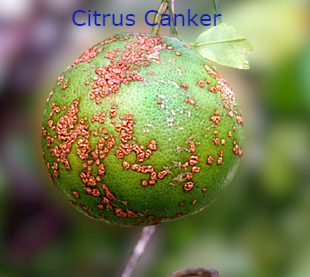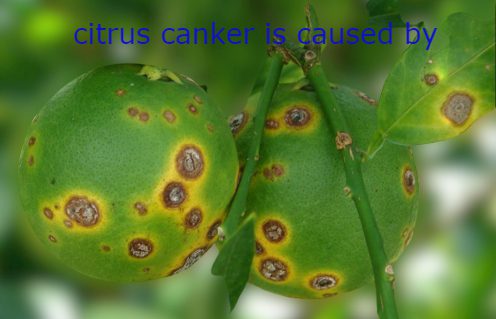Citrus Canker Disease
Citrus canker is known as blight disease also called sour of fruit is a dangerous bacterial disease that can wreak havoc on plants. The canker disease is caused by the bacterium Xanthomonas citri. The citrus canker disease is especially prevalent when the weather is hot and humid and new leaves and branches of plants are sprouting and it is raining. The Lemon sour disease spreads rapidly even in storms. Lemon fistula leaves a spot on the leaf and stains the fruit peel. But when the conditions are very favorable for infection, the fruit falls due to infection.
Canker disease Symptoms
The citrus canker disease affects all stages of plant growth. Symptoms on freshly affected leaves have small raised light brown dots on both sides. As these spots grow, they turn into rusty brown wart-like craters that fall out of specific but rather yellow holes. Spots erupt at once which expels their contents and becomes more spots from this material. The same symptoms appear on light brown or medium twigs and fruits. The canker disease often causes large leaves to fall off. In addition, the fruit falls prematurely. Even if the fruit does not fall off, when the fruit ripens, it is unsuitable for sale in the market.


Symptoms on Leaf
Lesions caused by citrus canker begin as pinpoint spots and grow to a maximum diameter of 2 to 10 mm. The size of the lesions is primarily determined by the age of the host tissue at the time of infection and the citrus cultivar. 7 to 10 days after infection, lesions appear on the underside of leaves, followed shortly thereafter by the upper surface. Young lesions are elevated or pustular on both leaf surfaces, but especially on the lower leaf surface. The pustules transform into corky, crateriform lesions with a raised rim and sunken core. The yellow halo that encircles lesions is a hallmark sign of the illness on leaves. The water-soaked edge that develops surrounding the necrotic tissue, which is easily spotted with transmitted light, is a more reliable indicator of citrus canker.
Citrus canker Lesions on Stem & Fruit
Lesions of citrus canker on fruit and stems are 1 mm deep and superficially similar to those on leaves. Symptoms on fruit can vary in size because the rind is vulnerable for a longer period of time than leaves, and multiple infection cycles may occur. Infected fruit may induce premature fruit drop, however, if the fruit remains on the tree until maturity, its marketability is diminished. In most cases, the internal quality of fruit is unaffected by lesions, but occasionally lesions penetrate the rind deeply enough to expose the inside to subsequent infection by decay organisms. Lesions on stems might persist for multiple seasons. Thus, stem lesions can assist the bacteria\’s long-term survival.
Canker is caused by
Citrus canker disease is caused by Xanthomonas citri. Which can live up to ten months on leaves and fruit. It enters the plant tissues through natural holes in the leaf surface and grows there. This bacterium spreads more when the humidity in the air is high as this environment becomes available when it rains and then the disease spreads. In addition, standing water for a long time can also spread the disease. In addition, the various conditions that promote the disease are high humidity of 20 to 30 degrees Celsius, rain with strong winds, and also spreads from birds and infected tools.
Disease Cycle of Citrus Canker
Bacteria proliferate in lesions on the leaves, stems, and fruit of plants. When there is moisture present on the lesions, the bacteria seep out and potentially infect new growth. Wind-driven rain is the primary agent of dissemination and winds less than 8 m/s (18 mph) aid the penetration of germs through stomatal pores or wounds caused by thorns, insects, and blowing sand. Pruning generates serious wounds that are susceptible to infection.
The majority of bacterial multiplication occurs while lesions are still expanding, and the amount of bacteria produced per lesion is proportional to the general sensitivity of the host. The bacteria survive in the lesions of leaves and fruit until they abscise and fall to the ground. It has also been found that bacteria can live in wounds on woody branches for several years. Bacteria that seep onto plant surfaces do not withstand rapid drying and begin to perish. Exposure to direct sunlight hastens the death of germs as well. Exposed bacteria can only survive a few days in soil and a few months in plant waste that has been integrated into the soil. The bacteria can, however, live for years in infected plant tissues that have been kept dry and free of soil.
Citrus Canker Treatment
Copper is the best citrus canker insecticide (Xanthomonas citri subsp. citri). Copper sprays are tailored based on tree row volume to reduce environmental consequences and expenses. Previous research reduced spray volume and copper rates. The results also suggested more research. This study aimed to minimize both the spray volume and the TRV-based metallic copper rate. A 3-year-old commercial Pera sweet orange orchard in Paranava, Paraná, Brazil, was tested over two seasons. 20 and 40cc of spray mixture per m3 of tree canopy were tested with 10, 21, 36,8, or 52.5 mg/m3 of metallic copper.
The disease was determined by leaf canker incidence, cumulative fallen fruit with canker, and harvest incidence. Copper deposition and leaf coverage measured spray quality. Combining 40 ml and 36.8 mg/m3 of water and copper had the best citrus canker control. The lowest threshold for copper deposition was 1.5 g Cu2+/cm2 leaf area, according to regression studies. The minimum spray volume and copper rate for deposition are 35 ml/m3 and 30 mg/m3. An insufficient surface covering prevented 20 ml/m3 from controlling the illness. This study showed that decreased copper and water concentrations do not affect citrus canker control.
- The affected parts of all the affected trees should be cut down and either burnt or buried in the ground. Drainage should be properly arranged.
- Adequate spacing should be done between the trees.
- The branches of plants that are meeting other plants should be cut off.
Citrus Canker Chemical Control
Citrus canker disease is chemically controlled using copper hydroxide spray.
Plants should be inspected thoroughly. All precautions should be taken while spraying

